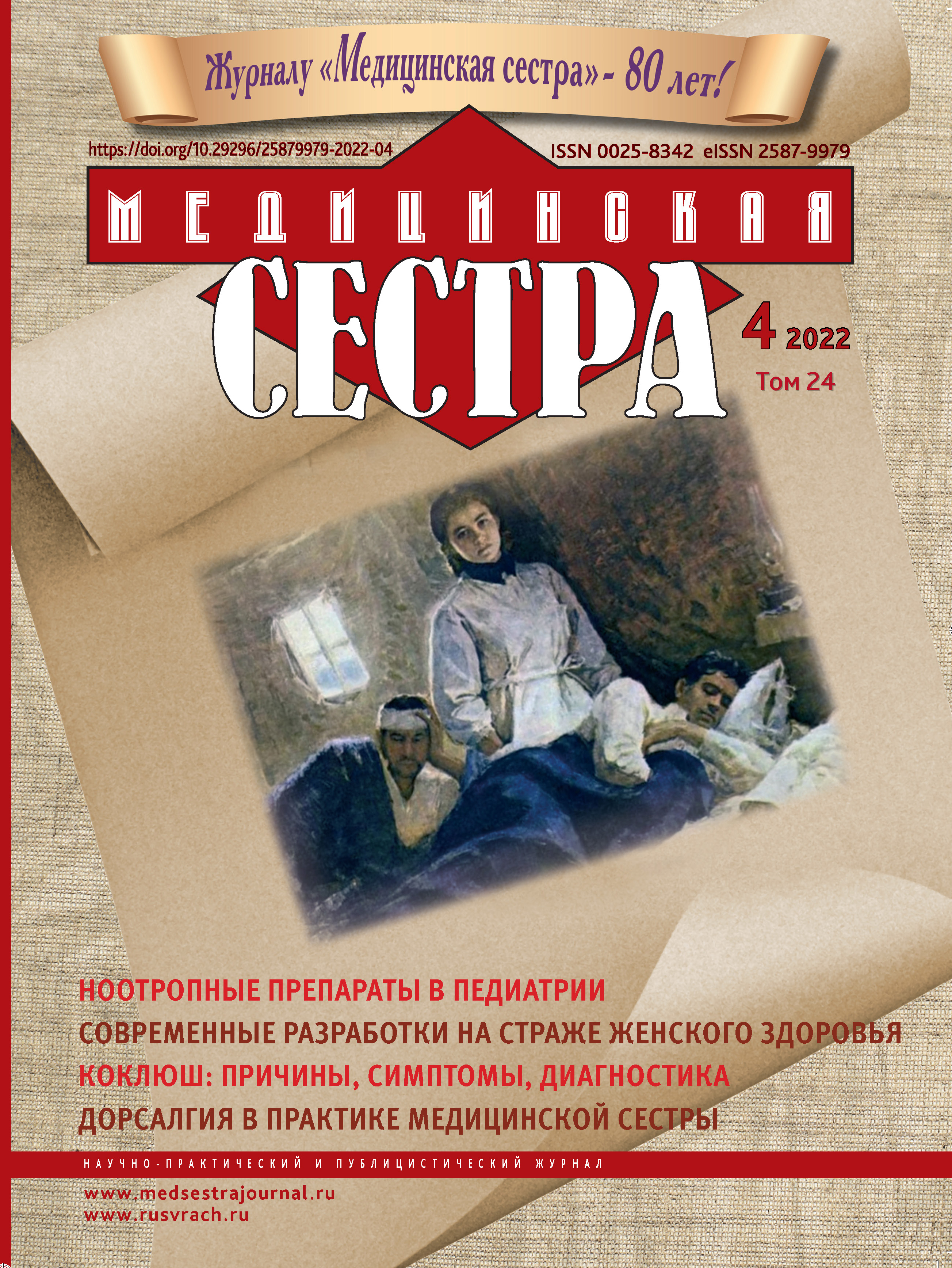Back pain (dorsalgia) in the practice of a nurse
- Authors: Skvortsov V.V.1, Matveyev N.D.1, Zadumina D.N.1
-
Affiliations:
- Volgograd state medical university of the ministry of health of the Russian Federation
- Issue: Vol 24, No 4 (2022)
- Pages: 34-37
- Section: Articles
- URL: https://journals.eco-vector.com/0025-8342/article/view/113962
- DOI: https://doi.org/10.29296/25879979-2022-04-06
- ID: 113962
Cite item
Abstract
In recent years, there has been a significant increase in the number of patients with diseases of the musculoskeletal system, often leading to the disability of patients. A special place in the structure of diseases of the musculoskeletal system is occupied by the lesion of the spine, which causes the development of back pain (dorsalgia). Dorsalgia is one of the most common reasons for patients seeking medical attention, ranking fifth among all visits. Dorsalgias are an extremely urgent problem in modern medicine. This is due to their widespread prevalence in the population, frequent damage to young people of working age, which also determines the socio-economic significance of this problem. Thus, episodes of back pain develop annually in half of the working-age population, most often occurring in persons aged 20 to 50 years. According to epidemiological studies, 63.5% of people develop dorsalgia at the age of 35–45, and in terms of the incidence of temporary disability they rank third after respiratory and circulatory diseases, accounting for about 25% of the total loss of working time.
Keywords
Full Text
About the authors
Vsevolod Vladimirovich Skvortsov
Volgograd state medical university of the ministry of health of the Russian Federation
Email: vskvortsov1@ya.ru
Doctor of Medicine, Associate Professor of the Department of Internal Medicine
Russian Federation, VolgogradNikita Dmitrievich Matveyev
Volgograd state medical university of the ministry of health of the Russian Federation
Email: nikita.mat.2012@mail.ru
student
Russian Federation, VolgogradDariya Nikolaevna Zadumina
Volgograd state medical university of the ministry of health of the Russian Federation
Author for correspondence.
Email: darya29.08@mail.ru
student
Russian Federation, VolgogradReferences
- Nasonov, E. L. «Pain in the pathology of the musculoskeletal system.» Vrach 4 (2002): 15-9.
- Parfenov V. A. Diagnosis and treatment of back pain RMJ. 2004; vol. 12, № 2: 115–119.
- Badokin V.V. The value of muscle relaxants in the relief of pain and muscle hypertonicity in rheumatic diseases BC. 2009, vol. 17, № 3: 190–194.
- WHO Department of Epidemiology and Community Health. Low back pain inciative. 1999.
- Alekseev, V. V. «Diagnostics and treatment of pains in a back.» Consilium medicum 4.2 (2002): 96-102.
- Shostak N. A., Ryabkova A. A., Khomenko V. V., Babadeva N. M. RMJ. 2003; vol. 11, № 23: 1316–1319.
- Shostak N. A., Pravdyuk N. G. The role of muscle spasm in the formation of pain in spondylarthrosis RMJ. 2005, vol. 13, № 10, reprint.
- Belen’kii, A. G., Nasonov E. L. «Dorsalgia in inflammatory diseases of the spine.» RMJ 11.7 (2003): 379-81.
- Badokin V.V. The use of Sirdalud in rheumatological practice RMJ. 2005; vol. 12, №. 24: 1586–1589.
- Parfenov V. A., Batysheva T. T. Back pain: painful muscle spasm and its treatment with muscle relaxants Attending Doctor. 2003, № 4: 34–39.
- Damulin I.V. Spasticity syndrome and the main directions of its treatment Journal of Neurology and Psychiatry. 2003; № 12: 4–9.
- Kukushkin M. L., Khitrov N. K. General pathology of pain. M.: Medicine, 2004.
- Shostak N. A., Pravdyuk N. G. Dorsopathies a new look at the problem of diagnosis and treatment Modern rheumatology. 2010; 1:28–31.
- Chichasova N. V. New approaches to the relief of acute pain in rheumatology and neurology Consilium Medicum. 2009, v. 11, № 2, p. 50–55.
- Nasonov E. L., Lazebnik L. B., Mareev V. Yu. et al. Use of non-steroidal anti-inflammatory drugs. Clinical guidelines. M., 2006.
- Rational pharmacotherapy of rheumatic diseases (guide for practitioners). Under the general editorship. V. A. Nasonova, E. L. Nasonova. M.: Litera, 2003. 506 p.
- Danilov A. B. Possibilities of using gizanidin (Sirdalud) in clinical practice. Literature review RMJ. 2009, vol. 17, № 19: 1–7.
- Coward D. M. Tizanidine: Neuropharmacology and mechanism of action Neurology. 1994; 44, 11 (Suppl. 9): 6–11.
- Sirdalud Ternilin Asia-Pacific group. Efficacy and gastroprotective effects of tinidizine plus diclofenac versus placebo plus diclofenac in patients with painful muscle spasm Curr Ther Res. 1998; 59:13–22.
- Ushkalova E. A. Centrally acting muscle relaxant tizanidine in clinical practice Consilium Medicum. 2005; vol. 7, № 8: 681–683.
- Parfenov V. A., Yakhno N. N. Neurology in general medical practice. M., 2001.
- Hutchinson D. R., Daniels F. A. A multinational study in general practice to evaluate the effectiveness and tolerability of tizanidine in the treatment of painful muscle spasms. Br J Clin Res. 1990; 1:39–48.
- Berry H., Hutchinson D. R. Tizanidine and ibuprofen in acute low-back pain: results of a double-blind multicentre study in general practice J Int Med Res. 1988; 16:83–91
- Vyshlova I.A., Simkhes Yu.V., Karpov S.M. Chronic back pain and metabolic disorders Physician. 2020. (31). № 12. S. 26-28.
- Vyshlova i., Simkhes Y.U., Karpov S. Chronic back pain and metabolic disorders Vrach. 2020. (31). № 12. 26-28.
Supplementary files







